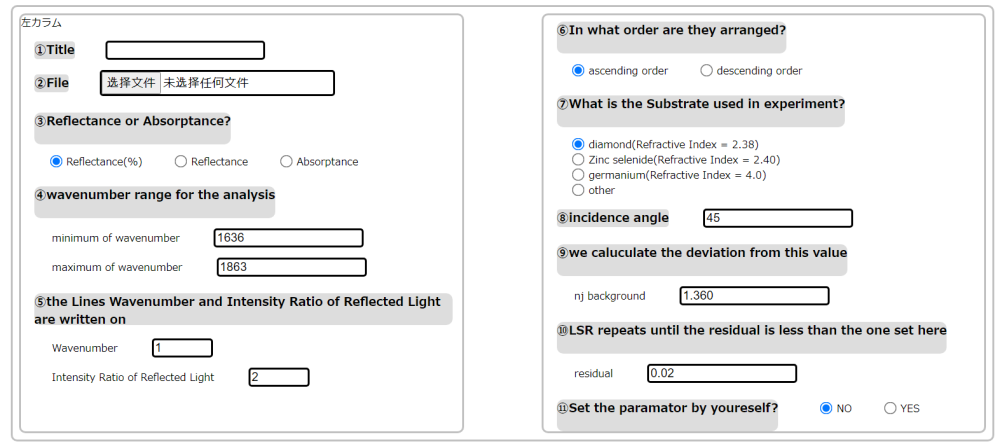「Input」の版間の差分
ナビゲーションに移動
検索に移動
| 48行目: | 48行目: | ||
---- | ---- | ||
<div id="Input07" style="font-size: 150%;"> ⑦Select the Substrate </div> | <div id="Input07" style="font-size: 150%;"> ⑦Select the Substrate </div> | ||
: Please select the substrate you used in the ATR-IR experiment. Here, we prepare the three substrates often used: Diamond(Refractive Index = 2.38) | : Please select the substrate you used in the ATR-IR experiment. Here, we prepare the three substrates often used | ||
:: Diamond(Refractive Index = 2.38) | |||
:: Zinc selenide(Refractive Index = 2.40) | |||
:: Germanium(Refractive Index = 4.0). | |||
: You can also input the refractive index of your substrate by selecting Others in the list. | : You can also input the refractive index of your substrate by selecting Others in the list. | ||
:[[File:manual_input7_other.png|500px]] | :[[File:manual_input7_other.png|500px]] | ||
| 61行目: | 64行目: | ||
: The refractive index of target sample in non-resnance region should be determined before the fitting procedure. In the reference paper, we use the refractive index values in the visible regions to fit Cauchy's equation. | : The refractive index of target sample in non-resnance region should be determined before the fitting procedure. In the reference paper, we use the refractive index values in the visible regions to fit Cauchy's equation. | ||
:: <math>n = A + \frac{B}{{\lambda}^2} + \frac{C}{{\lambda}^4}</math> | :: <math>n = A + \frac{B}{{\lambda}^2} + \frac{C}{{\lambda}^4}</math> | ||
: The obtained parameters <math>A, B, C</math> were used to evaluate the refractive index at 5000 | : The obtained parameters <math>A, B, C</math> were used to evaluate the refractive index at 5000 wavenumber. | ||
---- | ---- | ||
2021年12月20日 (月) 09:36時点における版
This is the typical snapshot of the input of ComplexRI. Each part will be explained in the following.
①Title
- Please input the title of your job (alphabet). The output results of ComplexRI will be saved in the excel format with the name @Title.xlsx
②File
- Please upload the ATR-IR experimental data in this part. The inside should be like the following.
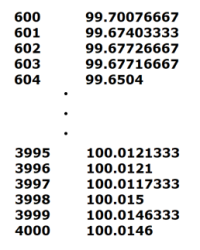
- There are two rules for the format of input file.
- (1). The format of input file must be txt.
- (2). The columns are separated by the space.
③The order of data
- Please select the sort order of your data.
- Ascending order: The frequencies in the input file are in ascending order (left picture). (Default)
- Descending order: The frequencies in the input file are in descending order (right picture).

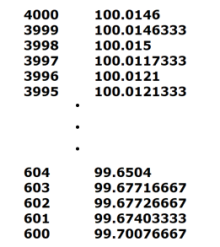
④Reflectance or Absorptance?
- Please select the type of your ATR-IR data.
- Reflectance(%): The Reflectance of ATR-IR spectra in the value of percentage. (Default)
- Reflectance: The Reflectance of ATR-IR spectra.
- Absorptance: The Absorptance of ATR-IR spectra.
- The relationships between each data are
⑤Select the column of your data
- Please input the column number of the data you want to analyze in your ATR-IR file.
- Wavenumber: The column number of wavenumber in your input file. (Default: 1)
- ATR-IR data: The column number of ATR-IR data in your input file. (Default: 2)
- For example, an input file like following can be uploaded and column 1 and column 5 can be selected for analyzing.
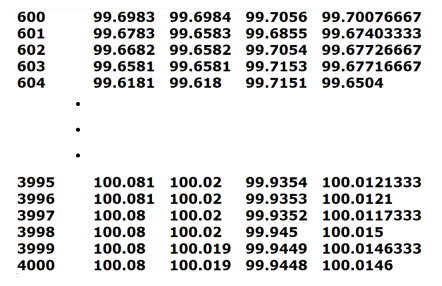
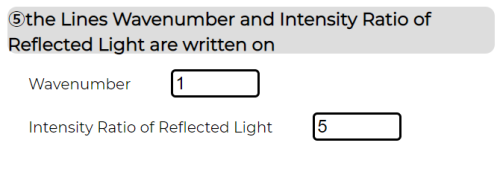
⑥Input the fitting range
- Please input the frequency range (in wavenumber) you want to perform the fitting. ComplexRI will fit the data only inside the range you input here.
- minimum wavenumber: The lower boundary of wavenumber. (Default: 1636)
- maximum wavenumber: The upper boundary of wavenumber. (Default: 1863)
⑦Select the Substrate
- Please select the substrate you used in the ATR-IR experiment. Here, we prepare the three substrates often used
- Diamond(Refractive Index = 2.38)
- Zinc selenide(Refractive Index = 2.40)
- Germanium(Refractive Index = 4.0).
- You can also input the refractive index of your substrate by selecting Others in the list.
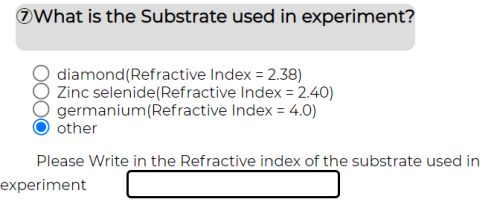
⑧Incident angle in ATR-IR
- Please input the incident angle in your ATR-IR experiment. (Default=45 degree)
⑨Refractive index of target sample in non-resnance region
- Please input the refractive index of the target sample non-resnance region. (Default=1.360)
- The refractive index of target sample in non-resnance region should be determined before the fitting procedure. In the reference paper, we use the refractive index values in the visible regions to fit Cauchy's equation.
- The obtained parameters were used to evaluate the refractive index at 5000 wavenumber.
⑩The tolerance of fitting ?
- Please input the tolerance of fitting procedure. The fitting will be finished when the calculated residual is less than this value.
- The details are written in the explanation01 of Internal processing.
- Notice!! Fitting can not finish if this value is too small.
11:How to set the parameter of the fitting function
- Here, you can select whether you decide the parameter of fitting functions. We use a set of Lorentz functions for fitting of Reflectance spectra as mentioned in the
explanation01 of Internal processing . Fitting function is like below.
- The default is set to “NO” like below.

- In this pattern, the parameters are assigned automatically.
- If you select “YES” like below.

- The new input fields are set, and you should give the number of Lorentz functions like below. The maximum of the number is 7.

- Above, the number is set to 1. So, the one set of three parameters of Lorentz function is need to input. init_A1, init_N1 and init_G1 are the amplitude, peak wavenumber, and bandwidth of Lorentz function, respectively.
